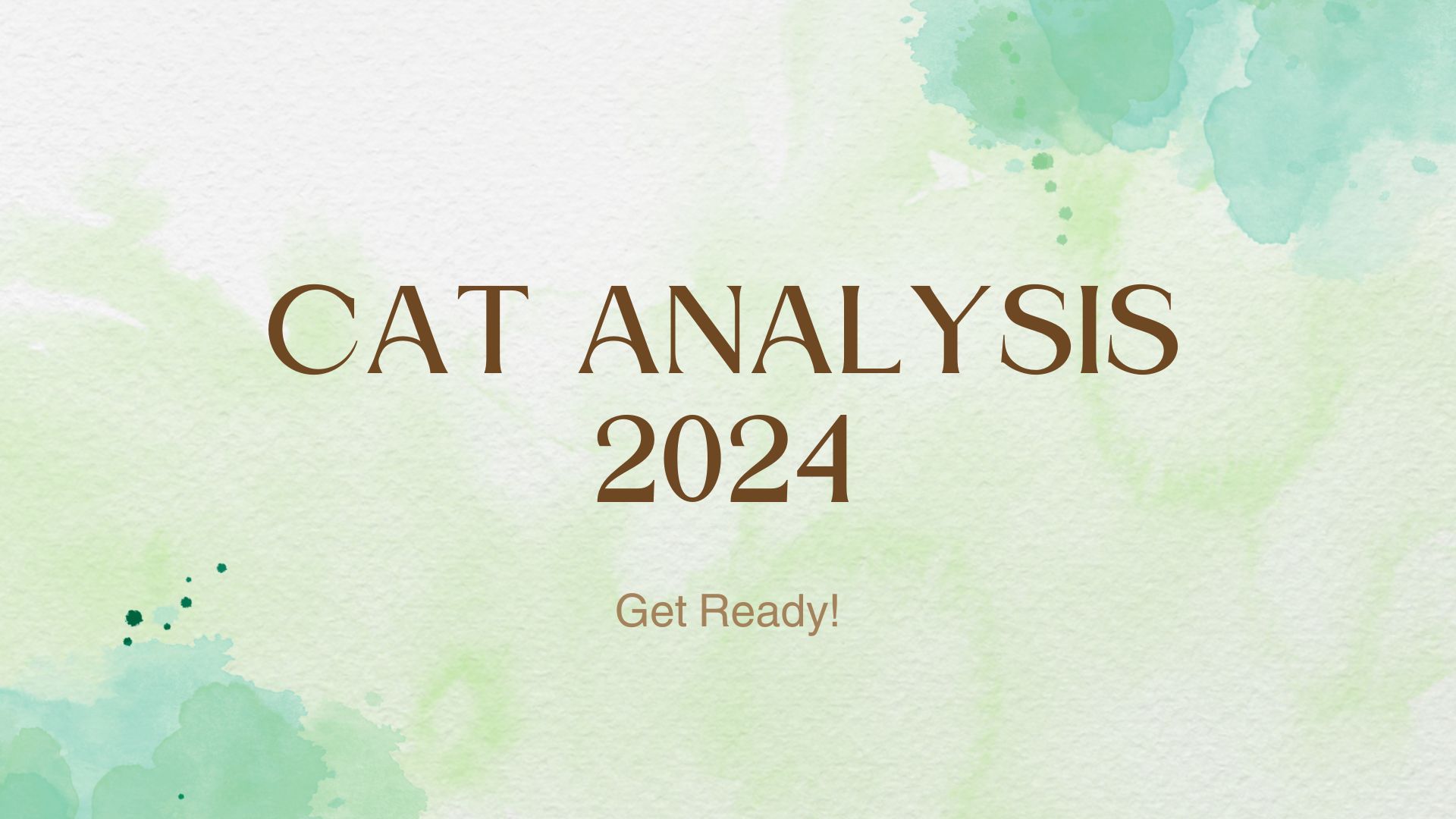Common Admission Test is one of the most coveted entry-level tests, attracting millions of applicants to seek admission into some of the country’s premier institutes on the MBA circuit, including the IIMs. The test has over two lakh applications every year, thereby making the cut-throat competition reach the extreme limit. Planning carefully and adhering diligently form part of preparation. However, like any other exam, CAT has its own list of pros and cons for students to weigh out before they commit themselves to the preparation process. This article carries an in-depth analysis of the pros and cons of CAT Analysis 2024.
Pros of CAT Analysis 2024
1. Gateway to Top B-Schools in India
One of the prime benefits of the CAT examination is that it serves as a ticket for entry into the best business schools in India, particularly IIMs. An excellent percentile at CAT opens doors to being a part of other elite institutions such as:
- Indian Institutes of Management
- Faculty of Management Studies
- SP Jain Institute of Management and Research
- Management Development Institute
- Indian Institute of Foreign Trade, by a specific entrance test.
- A good CAT percentile often opens up, as it were, pathways into successful careers in management with the opportunity of placements in leading global firms.
2. Holistic Assessment of Skill
CAT is more than just an aptitude test. It’s a holistic assessment of many skills:
- VARC – Verbal Ability and Reading Comprehension assesses linguistic as well as reading skills.
- DILR – Data Interpretation and Logical Reasoning tests the capabilities of analytical and logical reasoning.
- QA-Qualitative Ability evaluates mathematical and problem-solving abilities.
The balanced nature of the exam ensures that it tests a wide range of cognitive and analytical skills, which are essential in executing success in management roles.
3. Widely Recognised and Accepted
The CAT scores are accepted not only by the IIMs but also by many more top-tier B-schools in India. More than a thousand management institutes across the nation use CAT scores for their admissions to MBA. The vast recognition makes CAT a versatile option for students, where they can apply to several top institutes based on their performance in CAT.
4. Multiplicity of Opportunities for Improvement
CAT is an annual test, that is to say, the student gets more than one chance to enhance the scores. If a student is not satisfied with his performance in CAT Analysis 2024, then he can sit for the test next year with good preparation. It provides flexibility to those who want to aim for a higher percentile.
5. Improves Time Management and Solving Skills
In the process of preparation for CAT, one automatically develops better time management skills and problem-solving abilities which are must-haves, not only for the exam but also for a business management career. This is further fostered when it shapes and gets them accustomed to solving complex problems within constraints, a skill most useful in professional life, when such quick and informed decisions have to be made.
6. Allows Flexibility in Career Streams
Attainment of an MBA degree from a top B-school unlocks various career opportunities that include finance, consulting, marketing, operations, and human resource sectors. Students with high CAT percentile may opt for jobs in investment banks, management consultant firms, FMCG, IT, and many other sectors.
Disadvantages of CAT Analysis 2024
1. Highly Competitive
The biggest disadvantage of the CAT exam is that it’s extremely competitive. More than 2 lakh students compete every year for a few thousand seats in the top B-schools, especially the IIMs. As such, CAT is one of the toughest examinations in the country, because the competition is extremely rife. Even a 95th percentile may not guarantee a place in one of the top IIMs, as the cutoff requirements are extremely high and there are additional parameters such as academics, work experience, and interview performances.
2. Indeterminability of the Exam
The CAT is considered to be indeterminate. It does not pattern out as one would expect it to each year and hence students cannot really depend on their preparation based on the previous years’ pattern. For example,
- The DILR section could be really tough one year whereas the VARC section could have passages of reading comprehension tricky another year.
- CAT sometimes surprises students with unorthodox question types or poses them in ways so unexpected.
- This uncertainty can make the exam a cause for stress since an easy-going student will then not know what to expect on the day of the exam.
3. Time-Consuming Preparations
Preparation for CAT takes time. The student may dedicate several months of his or her life to the process. Some of the major subjects in preparation include:
Quantitative Aptitude; this entails arithmetic, algebra, geometry, and number systems among others.
- Verbal Ability and Reading Comprehension, which involves constant reading and vocabulary-building
- Data Interpretation and Logical Reasoning, which requires practice of wide techniques of problem-solving.
- This balance will not be possible with all other commitments of an undergraduate program or full-time work. Many students will have to compromise on personal life and hobbies.
4. Focus on Quantity and Quality
Speed and accuracy are the demands of the CAT exam; thousands of questions are to be solved in minimum time consumption with negative markings for any wrong answers. This gives rise to much pressure on the student to maintain both speed and precision in the test.
The pressure from quick answers and avoiding mistakes often seems beyond the reach of many students, especially for those who feel vulnerable to this pressure. In most cases, such pressure eventually develops into stress and affects performance.
5. High Cutoffs and Additional Selection Criteria
From the total number of aspirants appearing for CAT, students should have good scores in CAT. Though students score high percentiles, they have to meet other selection criteria like:
- Academic records (marks obtained in 10th, 12th, and graduation)
- Work experience
- Personal Interview scores (PI) and Written Ability Test scores (WAT)
- Group discussions for some institutes.
These additional criteria often make it very challenging for students who have poor academic records or any less experience in the workplace to be admitted into the top B-schools even though they score well in CAT.
6. Geographical Limitations
Some of the very best business schools in India consider CAT as the gateway. However, CAT may not really help students who would like to pursue management education outside India. Several universities abroad do not accept CAT scores and require GMAT or GRE scores to admit the student to the MBA program.
Conclusion
According to CAT analysis 2024, this year’s CAT exam is the third largest entrance to top business schools in India and comes with a great degree of benefits hence carrying too many challenges for MBA aspirants. It is known to be well versatile, allows various opportunities to improve, and sharpens timely management and solving skills in general, while its extreme competition, unpredictability, and long-duration preparation may turn down many students.
Candidates would have to weigh the pros against the cons of appearing for CAT, keeping them ready to undergo an intensive process. The rewards, though high, come coupled with that hard process to be achieved with dedication, resilience, and a strategic approach towards achieving success at one of India’s toughest entrance exams.
ABHAAS 10 Pcs Indian Handmade Artificial Marigold Garland Flowers for Decoration Long for Door Decoration Toran Genda Phool for Wedding/Festivals|4.2-4.9Ft| 5 Yellow + 5 Orange|10 Strings
₹284.00 (as of 22 October, 2024 18:22 GMT +05:30 - More infoProduct prices and availability are accurate as of the date/time indicated and are subject to change. Any price and availability information displayed on [relevant Amazon Site(s), as applicable] at the time of purchase will apply to the purchase of this product.)2 Pcs Kitchen Mats, Waterproof Memory Foam Kitchen Rugs, Standing Desk Mat Floor Mats, Comfort Runner Rug Carpets for Kitchen Floor, Sink (c)
₹549.00 (as of 22 October, 2024 18:23 GMT +05:30 - More infoProduct prices and availability are accurate as of the date/time indicated and are subject to change. Any price and availability information displayed on [relevant Amazon Site(s), as applicable] at the time of purchase will apply to the purchase of this product.)Rylan 2 in 1 Dumpling Maker Ghughra Momos Maker Machine, Skin Press Mould for Gujiya Ghughra Mould Machine, Kitchen Dumpling Making Tool with Dumpling Puri Maker(Design 1)
₹179.00 (as of 22 October, 2024 18:23 GMT +05:30 - More infoProduct prices and availability are accurate as of the date/time indicated and are subject to change. Any price and availability information displayed on [relevant Amazon Site(s), as applicable] at the time of purchase will apply to the purchase of this product.)SPARKLINE CO. Handcrafted Diya Shape Flower Decorative Urli Bowl for Home Perfect for Floating Flowers and Tea Light Candles Ideal Home and Table Decor Diwali Decoration Items Potpourri Bowl
₹394.00 (as of 22 October, 2024 18:23 GMT +05:30 - More infoProduct prices and availability are accurate as of the date/time indicated and are subject to change. Any price and availability information displayed on [relevant Amazon Site(s), as applicable] at the time of purchase will apply to the purchase of this product.)Perpetual Tea Light Candles Set of 50-100% Pure Wax, Smokeless, Tealight Candles for Home Decoration, 3 Hour Burniong Time Candles for Diwali,Christmas,New Year, Festivals
₹178.00 (as of 22 October, 2024 18:23 GMT +05:30 - More infoProduct prices and availability are accurate as of the date/time indicated and are subject to change. Any price and availability information displayed on [relevant Amazon Site(s), as applicable] at the time of purchase will apply to the purchase of this product.)Discover more from The General Post
Subscribe to get the latest posts sent to your email.





